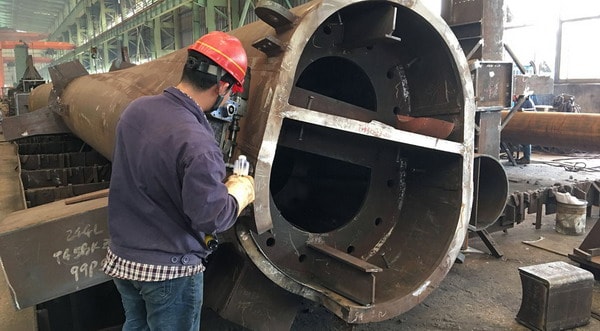
INTRODUCTION
Construction faces several challenges today. First, the complexity of construction projects has increased markedly, demanding greater technical and quality requirements. On the other hand, competition in the construction markets has increased significantly, mainly due to temporary variations in the demand for construction services and the entry of new competitors into the world market. Chile has not escaped this trend and it is possible to notice the presence of several foreign companies that, little by little, have joined the national market. It is clear that this trend will continue in the future. Finally, there is a strong demand from owners or constituents to reduce construction costs through better management of available resources. This last aspect is of particular relevance for a country with limited resources like ours.
Technology trends offer concrete possibilities to face these challenges. As in other environments, the construction industry must begin to seek and incorporate new ideas, new approaches to carry out construction projects, and leave behind its typical traditional system. Many technology trends that have been developed in other industries can be properly incorporated into construction. Also, many academic institutions, especially in developed countries, are proposing new techniques and / or methods and are actively researching to increase existing knowledge about construction.
The main purpose of this work is to explore the general concepts of technology trends and its application to the construction industry. First, the general conceptual basis of technology trends is reviewed. This base is then projected to the construction environment, taking into account its particular characteristics and needs. Finally, the main innovative trends that currently exist are reviewed, mainly in the United States and Japan.
In conclusion, the greatest current challenge of construction seems to be to begin to adapt to existing technological demands and opportunities.
CONCEPTS OF TECHNOLOGY TRENDS
General
According to dictionaries, innovation means “introduction of something new; change in the way of doing things”. On the other hand, technology corresponds to “the domain and use of production methods and industrial art‘ ’or also,” the systematic application of knowledge to practical tasks in the industry “.
Using the definitions presented, technology trends can be broadly defined as “the introduction of new ideas, knowledge, methods and devices to the way in which an industry develops its business or attempts a task”. For what? Why is it important? How to do it? The answers to these and other related questions will help to understand the general idea of technology trends and its importance.
The main reasons or incentives that a company has for technology trends are:
- This is a time of increasing competition in all fields, which will be increasingly strong in the future. Technology trends can offer the necessary comparative advantage to a company, and can become a basic survival requirement in this competitive environment. The literature offers many real cases that illustrate this point (1).
- It is the only way to keep up technologically, to be prepared to handle the technological changes and to incorporate all the potential they offer.
- Technology trends seeks to obtain greater productivity, reduce costs and improve products, objectives of undoubted appeal to any company.
Principles of technology trends
Several principles that must be applied for a successful technology trends, shared by most people, are discussed below. First, technology trends requires the commitment of the company (2,3). This implies believing in the potential benefits of technology trends, understanding them and incorporating them into the company’s short and long term planning. This can be considered practically as the first technology trends of the company.
Second, a positive attitude is needed within the company, which means having the support and participation of the company’s headquarters, structuring the organization of the company in order to favor technology trends and provide a creative environment for development of new ideas or the innovative application of current ones (4).
Third, technology trends means work and effort, it requires ingenuity, knowledge and concentration. It is specialized, must be practiced systematically and must be carefully planned and implemented.
Fourth, technology trends includes the analysis of sources of new opportunities with great potential (opportunistic orientation), should look for potential users (market approach), and should consider a multi-alternative approach. It also requires a long-term horizon for its evaluation (4).
Problems facing technology trends
There are several problems and barriers that hinder technology trends. The most important is the lack of support from the company’s headquarters due to the lack of understanding of the company or the lack of participation in it. There are people who think that investment in technology trends is a waste of money and time and therefore should be minimized. They normally use a short-term horizon for the evaluation of the economic benefits of potential technology trends.
Other people are so isolated from the productive area of the company that they do not have the opportunity to detect possible needs or existing opportunities for technology trends (4).
Inadequate organizational structures and bureaucratic barriers also have a negative effect on technology trends. This aspect is extremely critical in the stage of implementing an innovation.
The selection of areas of low innovation potential is also a fairly common problem. Generally, this is due to the non-existence of appropriate personnel within the company; to the small number of creative and ingenious people, or to the lack of experience of the company in new areas.
Another problem is the poor administration of the process of implementing innovations and knowledge transfer. A technology trends cannot be successful unless it is quickly and properly translated into practice or incorporated into a product. This implementation requires taking into account the user’s points of view or opinions, the training of the personnel in charge of the implementation, the use of motivation and incentive techniques and having the appropriate personnel. Another aspect that should not be neglected is the human factor during the implementation process (3). Resistance to change, fear of loss of power, rejection of products, etc., are typical problems that must be considered before carrying out the implementation.
Sometimes companies exaggerate their commitment and dedication to technology trends without taking care of the organization as a whole. This may be another important problem that results in a diminishing performance of other functions or areas of the organization. It is important not to forget the concept of system and avoid under optimization.
Implementation of technology trends
As indicated previously, senior management plays the most important role in making technology trends a success within a company. One of the most important decisions that must be taken into account is the change in the way in which the company is organized and managed, so that the technology trends process is efficient and correctly transformed into a practical application, be this a new product, the modification of a product, new methods or processes, new administration techniques, etc. These practical applications are the final expression of technology trends, and as such their performance should be measured using the most appropriate parameter. The most common parameters are: (a) the magnitude of the technical progress obtained from the investment in technology and (b) the amount of the profits obtained due to said progress (1).
The implementation of a technology trends must consider the following important factors:
- It requires meticulous preparation and planning, and must be carried out at the best time and place, according to the type of innovation (5).
- The selection of personnel to implement innovation is a critical activity. The team of people who coordinate the innovation study (3) must be composed of: i) a sponsor, who provides the necessary resources; ii) a promoter, who must be a good seller and problem solver; iii) a project administrator, who cares about administrative details; and iv) an integrator, who resolves conflicts of priorities and shapes the working group through the use of communication tools. Since these are roles, not people, an individual can take more than one role, or several people can perform a single function, depending on the magnitude and importance of the innovation.
- Those whose acceptance of innovation is critical for its implementation, must be identified early, and the way to address them must be carefully planned. The sources of rejection or fear of innovation must be understood and taken into account in the course of action chosen. A very powerful tool in this regard is incentives, especially monetary ones related to performance.
- The transfer of knowledge must be planned. To be successful, it is vitally important to choose appropriate opinion leaders among users. Frequently these leaders are those professionally distinguished and respected by the rest of the staff or users.
- Conduct pilot operations to test the technical feasibility of innovation and as a compelling demonstration model. To be convincing there can be no failures and the model must be clearly understood by all involved.
Do not forget that a technology trends rarely gains automatic acceptance from everyone, and that it is usually the subject of numerous and varied criticisms. These criticisms must be accepted and analyzed carefully. Sometimes a new innovation may be contained in them.
TECHNOLOGY TRENDS IN CONSTRUCTION INDUSTRY
Need for Technology trends in construction industry
The construction industry is increasingly concerned about the need to increase the productivity of construction processes. This is how research efforts in this area are currently being initiated in our country. Since construction technology is defined as the state of the art in construction methods, construction processes, construction equipment, construction materials and finally the administration of these elements; So it is logical to consider technology trends as one of the potential means to increase productivity in this activity.
In addition to the increase in productivity, the increase in quality requirements and the increasing complexity of construction projects also lead to consider technology trends to successfully meet these challenges. Due to this, the need to transform construction into a more technically efficient activity appears as preponderant (6).
Competition in the construction market has become very strong due, in part, to cyclical variations in the number of projects to be built, and partly due to the constant emergence of new competitors. This fact, plus other factors make it very important for a construction company to have an advantageous competitive position. As already mentioned, technology trends could allow the achievement of this position.
However, there are some conditions that must be present in a technology trends to be accepted in construction (7). These are:
- Technical feasibility: both resources and human capacity to apply technical knowledge must be available in the construction industry. This implies the need for training and especially recycling at professional levels through seminars, short courses, etc., that update the technical knowledge of these levels.
- Economic return: the construction industry is highly influenced by variations in interest rates, fluctuations in construction cycles and initial project costs. Construction will be willing to introduce innovations only if they result in increased profits, greater efficiency or a tangible advantage in the market.
- Cultural and institutional acceptance: the technology to be introduced must agree, to some extent, with the existing work and organization styles. Excessively radical changes cannot be made in a short period of time.
Technology trends and construction
Prior to addressing the issue of Technology trends in construction industry, it is necessary to review some important aspects of construction activity in relation to this issue.
First of all, we must understand that construction is a productive process that has as one of its main characteristics that it is an adaptable production process. It is adaptable because on each occasion, both the product to be built, and the surrounding environment, are significantly different in several aspects in relation to previous projects. It is possible to establish that construction is an activity dependent on the product to be built, and oriented mainly to the construction processes.
The products that a construction company offers are basically its technical capacity and its construction experience; that is its construction technology. The company provides a service to constituents or owners who wish to make a project a reality. A company that understands the potential of technology trends to improve its construction technology will be better able to compete for projects in the construction market.
Due to the important role that construction experience plays, technology trends is partly a learning process that grows on itself from empirical and trial-error systems, and partly develops from the individual creativity of the Construction staff This last aspect must be permanently encouraged.
Technology trends in construction industry can be carried out at three different levels: a) at the company level, b) at the project level and c) at the operational level.
At the company level, technology trends should focus on improving the performance of the company and its administration. The project planning and design system would also be influenced. Project support activities such as procurement, project engineering, budget estimation, could also be important areas to innovate. Finally, the company’s general policies regarding technology trends must be generated at this level.
At the project level, each project is itself a challenge for technology trends. Key aspects in innovation at the project level are creativity and staff experience. The project management team can act as a team in charge of innovation, so its composition is very important. At this level the focus should be how to carry out the project in the most efficient way, both in the technical aspect and in its administration, the latter being an area that offers great innovation potential. Finally, the process of implementing innovations in practice must be planned and carried out at this and the next level.
At the operational level, technology trends should focus on improving the techniques, methods, tools and materials used in construction, so that the production process at this level is extremely productive. Again, the administration area offers great innovation potential.
Each level must have its own manager, and it is a basic principle to integrate all participants in the construction process that have some influence on each level. In addition each level must be conveniently supported by the upper levels.
Each level must communicate its innovation needs to the higher levels so that the technology trends process is oriented to the satisfaction of these requirements. In short, management and construction support tools are the relevant objectives of technology trends. It is in these areas where the technical capacity that a construction company possesses.
Problems of innovation in construction
Despite the great potential that construction presents for technology trends, there are several aspects of construction that restrict this potential. These are:
- Poor knowledge transfer: one of the most difficult tasks facing construction is closing the gap between researchers and professionals working in this field. It is quite common to find a great contrast between the desire of researchers to challenge existing practices and generate radical alternatives from a certain position of objectivity and impartiality and the desire of people in the industry of smooth and gradual changes and transitions from a state to other (6). Many useful and innovative products can be derived from research efforts in the field of construction, but they have a very low value if they are not used or are not known in practice. It is important to mention that in general the needs of people in the industry are ambiguous and associated with specific situations and, therefore, do not always coincide with the results of the research. Clearly this is a problem of communication and integration. There is a need for convenient and accepted means to disseminate research in progress and there is also a need for researchers to contact construction professionals and incorporate their needs into the research projects they carry out. In countries like the United States there are institutions that combine the efforts of the academic area and the professional area for the development and technological advancement of construction. In our country a similar mechanism could also be activated through, for example, the Chilean Chamber of Construction and Universities.
- Management attitude and support: not all construction companies have positions in their organizational structure such as “Department of Technical Studies” or similar, whose main purpose is to analyze the processes, methods, equipment, etc., to study new alternatives, and subsequently implement those that are most appropriate. The lack of such positions considerably limits the technology trends process and demonstrates a lack of concern from management in this regard. Another consequence is that at the project and operational level, nothing will be done because generally at these levels the staff is too busy to devote time to analyze the technological aspects of the construction, nor do they manage to appreciate any benefits associated with such activity. Another case is when these roles exist in the organization but do not have any support to carry out their work; They do not have the necessary resources, their ideas are not taken into account and do not have any influence or power within the organization.
- Resistance to change: it is well known that in general construction personnel do not look with pleasure or easily accept the proposed changes, unless the benefits can be clearly evaluated by them. A typical answer to the question of why something is done in a certain way is that it has always been done so until that moment. Tradition is very strong in construction. Therefore, it is necessary to emphasize that no innovation implementation process can be successful if all those who must participate in this process do not agree with the change, including the frontline supervisory staff. A well-managed incentive plan can help greatly in this regard.
- Technology trends needs not identified or communicated: many times in construction innovation needs are not properly identified or communicated properly. Also, due to the lack of good communication in the field, many ideas or opportunities for innovation are lost because they are not known. Again, one way to improve this situation is through having an organization oriented towards technology trends and providing the necessary channels to communicate innovative ideas. The fact that there are many and diverse participants in construction is another barrier to innovation. Different people think and act differently when they face a certain situation. In addition, a well-thought-out technology trends may fail due to technological constraints of external participants (vendors, equipment suppliers, etc.)
Implementation of technology trends in construction.
In construction, as in the manufacturing industry, the process of implementing technology trends is one of the most important steps. The main aspects that should be considered are:
- The implementation process must be carefully planned and programmed. A recommended way to address the problem is through the use of the questions What ?, How ?, When ?, Where? and who?
- Obtain the necessary resources before starting. Many times it has happened that well-planned implementation processes have failed due to lack of resources.
- The end users of the innovation must be integrated during the analysis and planning, to obtain a commitment from them towards technology trends.
- The attitude of the implementing team must be positive. They should never use an aggressive style or try to impose things by force. Remember that it is very easy to make planned fail. For this reason, it is better to use incentives to convince.
- You should always start with a simple and small innovation to ensure initial success, especially during the demonstration stage. Solve difficulties before they happen in front of people who want to convince.
- Not forgetting the human element, especially those who may have personal fears or negative feelings in relation to the change.
- Maintain support until the innovation has been fully accepted and has passed into the routine category.
NEW TRENDS IN TECHNOLOGY TRENDS IN CONSTRUCTION INDUSTRY
General
Today there are several trends in the construction industry and in academic institutions in relation to technology trends. The classification given below was derived from the basic concept that construction is fundamentally a productive process.
Innovations related to the administration of the construction process
The administration is undoubtedly one of the most important fields of Technology trends in construction industry. In recent years a great deal of work has been done with the purpose of understanding and modeling the administration process of this complex activity, and identifying and solving its main problems. There is still much more to do. The main technology trends needs are in areas such as: (a) organizational structures of companies and construction projects, (b) communication in the field and between the different participants in a project, (c) information systems and support for the management, (d) planning and estimation and cost control, (e) administration of the interaction between the participants of a project and (f) integration of the aids and computational tools for decision making and other administration functions.
Innovations related to construction technology
This is another area of great innovation potential. The choice of the construction method to be used in a project is a critical decision that can have important consequences. The integration of the constructive experience in the design and planning stage of a project is one of the most recent areas and of future innovations. This topic is known as constructibility. Other fields of development are the organization and sequence of the construction process, and the systems used for this purpose. More efficient methods of procurement and purchases and the increasing use of prefabricated and pre-assembled components are topics that are subject to ongoing study and analysis. The use of new computational techniques in these areas is also an important source of change in construction technology.
Innovations in tools, materials and methods
Associated with the development and introduction of new materials and construction products, tools and equipment, and also, new systems and construction methods. This category of technology trends has always been a general practice in the construction industry. The most important factor promoting this development remains the need to reduce costs and achieve better use of resources. The Business Roundtable Report (9,10) reports propose specific technical areas of construction that would have a greater potential for technological development: pipe construction, installation of mechanical equipment, electrical work, structures, heating, ventilation and air conditioning, installation of special equipment and instrumentation.
Innovations related to the integration of computer systems in construction
The growing development and availability of new computer systems, which are increasingly cheaper and with greater capacity, is significantly influencing all types of human activity today, and will continue to do so in the future. With the integration of computer systems it is possible to see many innovations in construction. Some of the tools that offer possibilities of technological development in construction and that are available today are:
– Computer-aided design in 2 and 3 dimensions (CAD)
– Computer Aided Manufacturing (CAM)
– Computer aided communication (CAC)
– Automated systems and robots
– Expert knowledge-based systems (KBES)
– Administrative information systems (MIS)
– Management support systems (DSS)
These computer systems will make a wide variety of applications and uses available to the construction industry, which will result in important technology trends in the near future.
CONCLUSIONS
Technological development and advancement presents great potential as a means that the construction industry can use to face the challenges of the increasing complexity of current projects, increasing competition in the construction market and the demand for construction processes. More economically efficient construction. Technology trends offer a competitive advantage to any company that incorporates it into its business management.
To take advantage of the opportunities offered by technology trends, it is necessary to understand it, assess its economic potential and support its development. Senior management plays the most important role in ensuring that technology trends are a success. The evaluation of this effort must be done in the long term and not look towards the immediate but unstable benefit.
The construction industry presents good opportunities for innovation, given the great complexity of the construction processes. However, in order to take advantage of these opportunities it is necessary to overcome several important problems: a poor current transfer of knowledge, negative attitudes of senior management, resistance to change and lack of communications.
Several trends exist today in the construction environment. Continuous and growing development is expected which will offer a large number of technological advances. Construction should benefit from these advances through greater integration between researchers and potential users. Research efforts should be made to find better ways to carry out this integration, to facilitate communication and knowledge transfer between both parties and to make the process of implementing technological advances more effective.
REFERENCES
- Foster, Richard, “INNOVATION The Attacker’s Advantage”, Summit Books, New York, 1986.
- Frohman, Alan L., “Technology as a Competitive Weapon”, Harvard Business Review, January-February 1982, p. 97-104.
- Leonard-Barton, Dorothy and William A. Kraus, “Implementing New Technology,” Harvard Business Review, November-December 1985, P 102-110.
- Quinn, James B „” Managing Innovation: Controlled Chaos “, Harvard Business Review, May-June 1985, P- 73-84.
- Slade, Bernard N. and Raj Mohindra, “Winning the Productivity Race”, Chapter 5, Lexington Books, MA, 1985, P-27-37.
- Bakens, Ir W., “Construction Technology 2000”, Proceedings of the Ith Triennial Congress of the International Council for Building Research, Studies and Documentation, Washington, DC, USA, CIB. 86, Vol 2, p.538-546 .
- Ruberg, Kalev and Dan M. Sander, “Information and Knowledge for Building: A Role for Emerging Technology”, Proceedings of the 10th Triennial Congress of the International Council for Building Research, Studies and Documentation, Washington, DC, USA, CIB .86, Vol. 2, p. 498-505.
- Lansley, Peter R., “Bridging the Gap between Construction Management Research and Practice”, Proceedings of the 10th Triennial Congress of the International Council for Building Research. Studies and Documentation, Washington, D.C., USA, CIB. 86, Vol. 9, p. 3531-38.
- Technological Progress in the Construction Industry “, Construction Industry Cost Effectiveness Report B-2; The Business Roundtable, New York, July 1982.
- “Construction Technology Needs and Priorities”, Construction Industry Cost Effectiveness Report B-3, The Business Roundtable, New York, August 1982.




